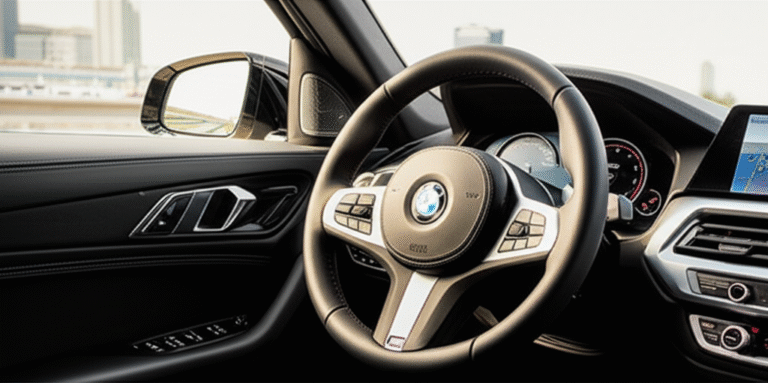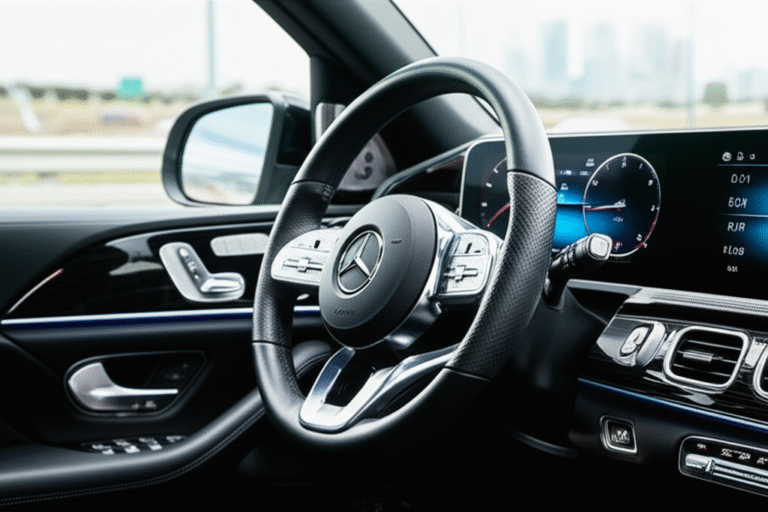BMW Cycle Fat Tyre: 6 Amazing Facts
Discover the BMW Cycle Fat Tyre: 6 Amazing Facts Revealed for a unique riding experience. Learn why these distinctive tires are more than just a style statement, offering superior performance and comfort.
Key Takeaways
- Explore the unique design of BMW fat-tire cycles.
- Understand the benefits of fat tires for various terrains.
- Learn about the engineering behind BMW’s fat-tire bikes.
- Discover how fat tires enhance ride comfort and stability.
- Uncover the versatility of these impressive cycles.
- Appreciate the fusion of BMW’s automotive legacy with cycling innovation.
Have you seen those eye-catching bicycles rolling around, with tires that look like they belong on a mountain or even a beach cruiser? These are often referred to as “fat tire” bikes, and when they carry the prestigious BMW badge, they represent a unique blend of automotive engineering and cycling prowess. You might be wondering what makes a BMW Cycle Fat Tyre so special. It’s not just about the bold aesthetics; there’s a whole lot of innovation packed into these machines.
Navigating the world of specialized bicycles can sometimes feel a bit confusing, but understanding the core features of a BMW Cycle Fat Tyre is simpler than you think. We’re here to break down exactly what makes them stand out. Get ready to discover six amazing facts that highlight the engineering, performance, and versatility of these remarkable cycles. Let’s dive in and explore the fascinating world of BMW’s fat-tire offerings.
1. What Exactly is a BMW Cycle Fat Tyre?
At its core, a BMW Cycle Fat Tyre refers to a bicycle equipped with tires that are significantly wider than those found on traditional bikes. We’re talking about tires that can range from 3.8 inches to an impressive 5 inches or even more in width. This dramatic increase in tire volume is the defining characteristic. While BMW is globally recognized for its luxury automobiles and motorcycles, their foray into bicycles, particularly those featuring fat tires, showcases their commitment to diverse mobility solutions and innovative design.
Think of it this way: your standard road bike might have tires around 23-28 millimeters wide. A mountain bike might step up to 2-2.5 inches. A fat tire bike blows those out of the water. This isn’t just for show; this exaggerated width has a profound impact on how the bike performs. It’s a deliberate design choice aimed at maximizing surface contact and providing unparalleled flotation and comfort. When you see a BMW Cycle Fat Tyre, you’re looking at a machine engineered to go where other bikes might struggle.
2. The Science Behind the Float: How Fat Tires Conquer Terrain
The magic of a BMW Cycle Fat Tyre lies in its ability to distribute weight over a much larger surface area. This is similar to how a snowshoe allows you to walk on snow without sinking. When you inflate a fat tire, you do so at a much lower pressure – often as low as 5-15 PSI, compared to the 50-80 PSI of a road bike tire. This low pressure allows the tire to deform and conform to uneven surfaces.
This characteristic makes them incredibly versatile. Here’s a breakdown of how this science translates to different terrains:
- Sand: The wide contact patch prevents the bike from digging into soft sand, allowing you to glide over beaches and sandy trails with surprising ease.
- Snow: Just like in sand, the fat tires distribute your weight, providing traction and flotation on packed or soft snow. This opens up winter cycling opportunities.
- Mud: The wider tire can often find better traction in muddy conditions by spreading the load and reducing ground pressure, acting almost like a miniature tank tread.
- Rocky and Uneven Trails: The lower tire pressure acts as natural suspension, absorbing bumps and vibrations. This makes for a smoother, more comfortable ride over roots, rocks, and rough terrain.
The engineering behind these tires, often found on BMW’s premium bicycle models, ensures that this increased contact doesn’t necessarily mean sluggishness. They are designed to balance stability and maneuverability, a testament to BMW’s automotive precision applied to cycling.
3. Enhanced Comfort and Shock Absorption: A Smoother Ride
One of the most immediate benefits you’ll notice with a BMW Cycle Fat Tyre is the incredible ride comfort. The large volume of air within the tire acts as a natural suspension system. This means that smaller bumps, cracks, and vibrations that would normally transmit through the frame and into your body are absorbed by the tire itself.
For everyday commuting or leisurely rides, this translates to a significantly more comfortable experience. You’ll feel less fatigue on longer journeys, and the ride will feel smoother, even on less-than-perfect pavement. It’s like having built-in shock absorbers for your bike. This is particularly appealing for riders who might experience discomfort on traditional bikes due to jarring impacts.
Beyond comfort, this shock absorption also contributes to increased stability. The tire’s ability to conform to the ground means a more consistent contact patch, which can lead to better control, especially when navigating unpredictable surfaces. This level of refined comfort and control is a hallmark of the BMW brand, extending seamlessly to their bicycle offerings.
4. Durability and Resilience: Built to Last
The robust nature of fat tires means they are exceptionally durable. The thicker rubber and reinforced sidewalls are designed to withstand more abuse than standard bicycle tires. This makes them an excellent choice for riders who plan to tackle challenging trails or simply want a bike that can handle a bit of everything without constant worry about flats or damage.
Consider the construction: fat tires are built with more material, providing a greater buffer against sharp rocks, thorns, and debris that might puncture thinner tires. While no tire is completely immune to punctures, the fat tire’s inherent strength and the lower operating pressure contribute significantly to their resilience. This durability aligns perfectly with BMW’s reputation for building high-quality, long-lasting products.
This resilience means less time spent on maintenance and more time enjoying your ride. Whether you’re an urban explorer navigating city streets, a weekend warrior hitting off-road paths, or an expat looking for a reliable mode of transport in diverse American landscapes, the durability of a BMW Cycle Fat Tyre offers peace of mind.
5. Versatility: From City Streets to Snowy Trails
The true beauty of a BMW Cycle Fat Tyre lies in its remarkable versatility. It’s not a one-trick pony; it’s an all-terrain champion. Whether you’re looking to cruise along a boardwalk, tackle a challenging mountain bike trail, or even venture out in winter conditions, a fat tire bike can handle it.
Here’s a snapshot of its multi-terrain capability:
| Terrain Type | Performance | Considerations |
|---|---|---|
| Paved Roads | Comfortable, stable ride. Can feel slightly slower due to rolling resistance. | Ideal for commuting and leisurely rides with a smooth feel. |
| Gravel Paths | Excellent traction and shock absorption, making rough gravel feel smooth. | Handles uneven surfaces with ease, offering a secure grip. |
| Dirt Trails (Singletrack) | Superior control and grip, especially on loose or technical terrain. | The low pressure allows tires to contour over obstacles. |
| Sand Beaches | Exceptional flotation, preventing the bike from sinking. | Opens up beach riding possibilities not available to most bikes. |
| Snow and Ice | Provides traction and stability in winter conditions. | Lower pressures are key; some riders opt for studded tires for icy conditions. |
| Muddy Conditions | Good grip by distributing weight and minimizing rutting. | Can perform well, but performance varies with mud consistency. |
This adaptability makes a BMW Cycle Fat Tyre an attractive option for anyone living in areas with varied weather and terrain, which is common across the USA. From the coastal paths of California to the snowy trails of Colorado, or even just navigating the urban jungle of New York, these bikes are designed to impress.
6. Blending Automotive Legacy with Cycling Innovation
BMW’s reputation in the automotive world is built on decades of engineering excellence, performance, and sophisticated design. When they apply this philosophy to bicycles, the result is a product that feels premium and performs exceptionally. The BMW Cycle Fat Tyre isn’t just a fat-tire bike; it’s a BMW fat-tire bike.
This means you can expect attention to detail in every aspect, from the frame geometry and material choices to the component selection and overall aesthetic. They often incorporate sleek lines, high-quality finishes, and thoughtful features that reflect their automotive heritage. The goal is to create a cycling experience that is as enjoyable and refined as driving a BMW.
Think about the innovations seen in BMW cars – advanced suspension, aerodynamic design, and driver-centric ergonomics. These principles are often translated into their bicycle designs. For instance, the frame might be engineered for optimal balance and handling, much like a car’s chassis. The rider interface, including handlebars and saddle, is designed for comfort and control, mirroring the ergonomic considerations in a car cockpit. This fusion creates a cycling machine that is both technologically advanced and a pleasure to ride.
Pro Tip:
When considering a BMW Cycle Fat Tyre, always check tire pressure before each ride, especially if the bike has been stored for a while. Proper inflation is crucial for optimal performance and comfort across different terrains.
Frequently Asked Questions (FAQ)
Are BMW Cycle Fat Tyres good for long-distance riding?
Yes, BMW Cycle Fat Tyres can be excellent for long-distance riding, especially on varied terrain. The inherent comfort and shock absorption provided by the fat tires reduce rider fatigue. While they might have slightly more rolling resistance on perfectly smooth pavement compared to a road bike, their ability to smooth out bumps and rough patches can make a long ride much more enjoyable and less strenuous. Many riders find the comfort benefits outweigh the marginal increase in effort on smooth surfaces.
How do I adjust the tire pressure on a BMW Cycle Fat Tyre?
Adjusting tire pressure on a BMW Cycle Fat Tyre is straightforward. You’ll need a pressure gauge compatible with low pressures (often marked in PSI). To lower the pressure, simply press the pin in the valve stem with the gauge or your finger. To increase pressure, attach a pump to the valve and pump until the desired PSI is reached. Refer to the tire or bike manufacturer’s recommendations for optimal pressure ranges for different terrains.
Can I ride a BMW Cycle Fat Tyre in the rain?
Absolutely, you can ride a BMW Cycle Fat Tyre in the rain. In fact, the wider tires often provide better traction in wet conditions due to their increased contact patch. The lower tire pressure also helps them grip the road surface more effectively. However, always exercise caution in wet weather, and ensure your brakes are in good working order. Consider using fenders to keep yourself and your bike cleaner.
What kind of maintenance does a BMW Cycle Fat Tyre require?
A BMW Cycle Fat Tyre requires regular bicycle maintenance, similar to other types of bikes. This includes keeping the chain lubricated, checking brake pads for wear, ensuring bolts are tight, and cleaning the bike regularly. The fat tires themselves are quite durable, but it’s still wise to inspect them for any damage or embedded objects. Because they run at lower pressures, checking the pressure regularly is also a key part of maintenance.
Are fat tires heavier than standard bike tires?
Generally, yes, fat tires are heavier than standard bicycle tires due to the increased volume of rubber and the wider rim they require. This added weight can contribute to slightly slower acceleration on flat surfaces. However, the benefits of increased traction, comfort, and flotation on challenging terrain often make this a worthwhile trade-off for many riders, especially those looking for a versatile and forgiving riding experience.
Where can I buy a BMW Cycle Fat Tyre?
You can typically find BMW Cycle Fat Tyres through authorized BMW dealerships that offer lifestyle products, or through reputable online retailers specializing in premium bicycles. It’s always recommended to buy from authorized sources to ensure authenticity and access to warranty services. Visiting a dealership can also provide the opportunity to test ride the bike, allowing you to experience its unique characteristics firsthand.
For more information on cycling regulations and recommendations in the USA, you can refer to resources from organizations like the League of American Bicyclists, which provides valuable insights into safe cycling practices and advocacy across the country.
Do BMW Cycle Fat Tyres offer different gear options?
Yes, BMW Cycle Fat Tyres can come with a variety of gearing options, just like other bicycles. Depending on the specific model and its intended use – whether for casual cruising, trail riding, or commuting – you might find them equipped with single-speed setups, internal gear hubs, or multi-speed derailleur systems. This allows riders to choose a bike that best suits their local terrain and personal riding style.
Conclusion
The BMW Cycle Fat Tyre represents a fascinating intersection of automotive heritage and modern cycling innovation. These bikes are far more than just a stylish statement; they are engineered for exceptional performance, remarkable comfort, and unparalleled versatility. From their ability to conquer diverse terrains like sand, snow, and rugged trails, to the inherent durability and smoother ride they offer, there are indeed many amazing facts to appreciate.
Whether you’re a seasoned cyclist looking for a new adventure, a commuter seeking a more comfortable and capable ride, or simply someone intrigued by sophisticated design and engineering, a BMW Cycle Fat Tyre might just be the perfect two-wheeled companion. They embody BMW’s commitment to mobility, quality, and a refined user experience, translating their automotive prowess into a truly delightful cycling journey.




